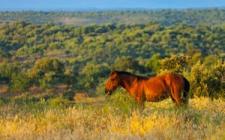Bringing back nature to the EU in the post-2020 Biodiversity Strategy

The rewilding of European ecosystems can help to tackle both the current climate and biodiversity emergencies.
We are currently facing two global environmental emergencies: biodiversity loss and climate change. While they are often considered in isolation, many of their underlying causes are linked to unustainable development. The recovery of nature through rewilding, and the associated enhancement of nature-based solutions, offers a way to effectively address both crises simultaneously.
Recognising and advocating this twin-track approach, the WWF European Policy Office, BirdLife Europe & Central Asia, the European Environmental Bureau, Rewilding Europe, the German Centre for Integrative Biodiversity Research (iDiv) and the Martin Luther University Halle-Wittenberg have released a policy brief calling on the European Commission to prioritise rewilding in the EU Biodiversity Strategy post-2020. By proposing ambitious nature restoration targets and legislation, the strategy would ensure the recovery of nature at landscape-scale across Europe, providing solutions to both the climate and biodiversity crises, helping the EU meet its biodiversity and climate targets, and benefitting every European citizen.
"The large-scale restoration of European nature will not only help to halt and reverse biodiversity decline, it will also protect carbon reservoirs on land and in the seas, and remove carbon from the atmosphere," says Prof Henrique Pereira, head of the Biodiversity Conservation group at iDiv and MLU. "The Biodiversity Strategy post-2020 should, therefore, propose legally binding targets for the restoration of degraded habitats, using rewilding principles, and ensure financing for climate action delivers active restoration of natural habitats on land and at sea."
Enhancing solutions
Nature-based solutions are actions that work with wild nature and natural processes to help mitigate and overcome society's challenges. The new policy brief outlines the many ways in which the large-scale restoration of European nature would see the enhancement of such solutions mitigate the impact of climate change and boost climate resilience.
For example, forest restoration could sequester up to two thirds of the accumulated carbon dioxide emissions in the Earth's atmosphere, contributing decisively to limit global warming below 1.5°C. Such efforts will only be effective if directed towards the restoration of natural, biologically complex and self-sustained forests, because single species plantation forestry often damages existing biodiversity and can be more prone to wildfire and disease.
The restoration of peatlands also offers a cost-effective approach to climate change mitigation. Naturally functioning peatlands sequester carbon from the atmosphere, laying it down as peat. But the majority of European peatlands have been damaged through drainage, peat extraction, forestry or burning, causing the peat to dry, oxidise and release carbon dioxide into the atmosphere, rather than locking it up. Rewetting peatlands can reverse this damage and restore their carbon absorption function.
Meeting targets
The policy brief also outlines how the rewilding of European ecosystems, through the restoration and maintenance of ecologically functional and connected landscapes, wetlands and floodplains, is critical to achieving the objectives of the EU's Birds and Habitats Directives and the Water Framework Directive.
The EU Biodiversity Strategy was adopted by the European Commission in 2011 to combat the decline of biodiversity and nature-based services in the EU. While the strategy to 2020 aimed to "restore at least 15% of degraded ecosystems", a mid-term evaluation carried out in 2015 made it clear that progress on this target has been largely insufficient. A fitness check of the EU Nature Directives carried out in 2016 pointed to the lack of connectivity in the EU's network of Natura 2000 sites as one of the mainproblem areas.
In addition to mitigating the scale and impact of climate change, landscape-scale nature restoration would improve both the conservation status and the connectivity of the Natura 2000 network.
Delivering cost-effective change
The new policy brief calls for the EU Biodiversity Strategy post-2020 to ensure legally binding restoration targets are laid down for member states. Such targets would encompass the restoration of set areas of natural forest, peatland, floodplain, wetland and biodiversity-rich grassland, as well as coastal and marine zones. Planned afforestation in the context of this agenda would focus on the urban planting of native species while natural regeneration would be promoted elsewhere.
The costs of large-scale ecosystem restoration are often prohibitive - this is another reason why the EU is currently falling short on its restoration targets. As the policy brief points out, restoring self-sustaining, functioning ecosystems that require little human intervention can help to reduce the financial burden of creating coherent ecological networks, supporting restoration at greater scale and providing new opportunities for managing land that is otherwise economically unproductive.
Working with restored nature can - in a timely and cost-effective way - draw down carbon from the atmosphere, protect us from flooding and coastal erosion, stabilise crops, minimise the threat of wildfire, secure drinking water supplies, ensure human health and wellbeing, and drive economic growth. By supporting rewilding, the EU Biodiversity Strategy post-2020 can help to deliver all these benefits and more.
(Based on a media release of Rewilding Europe)
Original publication: Henrique M. Pereira, Néstor Fernández, Andrea Perino, Josiane Segar, Frans Schepers, Rob Stoneman (2020). Ecological restoration in the EU post-2020 biodiversity strategy: The opportunities of rewilding European landscapes for nature and climate.




